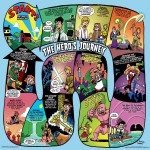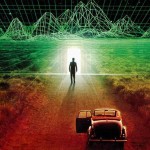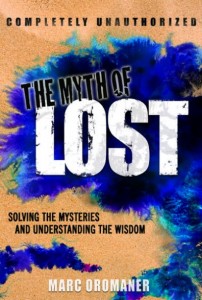 Enlightenment. The moment we consciously connect to eternal truth. It’s when we see through the veil of this illusionary world, rising above ego, time, materialism, and our own emotions to see the bigger picture—that we are all one. It’s what all gurus, spiritualists, yogis, Buddhists, monks, meditators, shamans, artists, writers, and religious leaders strive for. It’s the state Neo reached at the end of The Matrix, the level Dorothy attained so she could surpass time and space and return home, and the brief moment you get a taste of, usually in the shower, when your brain skips a beat on the record of reality, resulting in a little inspiration in line with your true self. But is there any way to speed up the process or at least know how close you are to the fully enlightened experience? I believe there is. And it’s something so unbelievably simple, you’ll be able to master it shortly after reading this blog posts.
Enlightenment. The moment we consciously connect to eternal truth. It’s when we see through the veil of this illusionary world, rising above ego, time, materialism, and our own emotions to see the bigger picture—that we are all one. It’s what all gurus, spiritualists, yogis, Buddhists, monks, meditators, shamans, artists, writers, and religious leaders strive for. It’s the state Neo reached at the end of The Matrix, the level Dorothy attained so she could surpass time and space and return home, and the brief moment you get a taste of, usually in the shower, when your brain skips a beat on the record of reality, resulting in a little inspiration in line with your true self. But is there any way to speed up the process or at least know how close you are to the fully enlightened experience? I believe there is. And it’s something so unbelievably simple, you’ll be able to master it shortly after reading this blog posts.
 When you’ve seen as many movies as I have, you begin to see that they all follow a certain pattern. This is true not just of movies, but of all great stories ranging from those found in classic mythology and literature to modern TV series and video games. Joseph Campbell called it the monomyth or hero’s journey. It’s basically a series of steps that the protagonist must go through during the course of his or her adventure. In addition to this, there are also a number of spiritual principles that often find their way into storytelling. By combining these principles with the monomyth, you can pretty much figure out where just about any story is headed. While this skill has proven to be incredibly annoying to my wife, it’s come in very handy for me. Not because I’ve continually annoyed her with my usually correct movie and TV show predictions, but because I’ve noticed that these storytelling rules apply to more than just fictitious stories. They also apply to real life.
When you’ve seen as many movies as I have, you begin to see that they all follow a certain pattern. This is true not just of movies, but of all great stories ranging from those found in classic mythology and literature to modern TV series and video games. Joseph Campbell called it the monomyth or hero’s journey. It’s basically a series of steps that the protagonist must go through during the course of his or her adventure. In addition to this, there are also a number of spiritual principles that often find their way into storytelling. By combining these principles with the monomyth, you can pretty much figure out where just about any story is headed. While this skill has proven to be incredibly annoying to my wife, it’s come in very handy for me. Not because I’ve continually annoyed her with my usually correct movie and TV show predictions, but because I’ve noticed that these storytelling rules apply to more than just fictitious stories. They also apply to real life.
 “We’re all connected.” It’s the ubiquitous mantra of new-agey types. Chances are if you’ve ever watched Oprah, were a fan of the TV show Lost, or have read just about anything I’ve written, you are very familiar with this concept. Along with its close cousin “everything happens for a reason,” it’s pretty much become a cliché that isn’t really given much thought. Yet, how exactly are we all connected? Sure, we’re all made of the same elements, live on the same planet, and are plugged into the same Internet, but the phrase usually refers to the idea that all of our minds are somehow connected, that our lives are intertwined, that actions taken by you, now, could somehow affect a struggling shoe salesman living in Uzbekistan. I think it’s about time we explored this concept and saved it from the nether regions of trite, hackneyed banality. After all, if the idea that “we’re all connected” is a given, why doesn’t anyone (with the possible exception of Oprah herself) really believe it?
“We’re all connected.” It’s the ubiquitous mantra of new-agey types. Chances are if you’ve ever watched Oprah, were a fan of the TV show Lost, or have read just about anything I’ve written, you are very familiar with this concept. Along with its close cousin “everything happens for a reason,” it’s pretty much become a cliché that isn’t really given much thought. Yet, how exactly are we all connected? Sure, we’re all made of the same elements, live on the same planet, and are plugged into the same Internet, but the phrase usually refers to the idea that all of our minds are somehow connected, that our lives are intertwined, that actions taken by you, now, could somehow affect a struggling shoe salesman living in Uzbekistan. I think it’s about time we explored this concept and saved it from the nether regions of trite, hackneyed banality. After all, if the idea that “we’re all connected” is a given, why doesn’t anyone (with the possible exception of Oprah herself) really believe it?
 Those who move in spiritual circles often talk about how we are all connected, that our thoughts create our future reality, and that the universe provides us with clues about our direction in life. Personally, I look at spiritual principles as scientific rules that we just don’t understand yet. Not too long ago, the idea that people could get sick from tiny bugs they couldn’t see or that invisible waves could carry images or music was thought to be magical thinking, until science proved it to be true. So if these spiritual principles are indeed a rule of our universe, there should be a way to test and predict their occurrence. Doing this on an individual scale might prove challenging though, since one person’s thoughts may not have enough energy to make something manifest in a testable way. But what if there were an event that millions of people were focusing on, and this event inspired heated, emotionally charged thoughts that could result in only one of two possible outcomes? If only we had such an event, why, we just might be able to predict the future on a grand scale!
Those who move in spiritual circles often talk about how we are all connected, that our thoughts create our future reality, and that the universe provides us with clues about our direction in life. Personally, I look at spiritual principles as scientific rules that we just don’t understand yet. Not too long ago, the idea that people could get sick from tiny bugs they couldn’t see or that invisible waves could carry images or music was thought to be magical thinking, until science proved it to be true. So if these spiritual principles are indeed a rule of our universe, there should be a way to test and predict their occurrence. Doing this on an individual scale might prove challenging though, since one person’s thoughts may not have enough energy to make something manifest in a testable way. But what if there were an event that millions of people were focusing on, and this event inspired heated, emotionally charged thoughts that could result in only one of two possible outcomes? If only we had such an event, why, we just might be able to predict the future on a grand scale!
 Back in June 2009, I wrote an article titled “Proof That We’re Living a Life of Illusion.” In it, I provided what I felt was overwhelming evidence that we all live in some kind of computer simulation. I also offered some simple explanations as to why I thought we did. At the time, the people who are open to believing in such fantastical theories excitedly agreed with the premise, while those who rely on hard-core scientific proof, did not. Well, a funny thing’s happened in the years since I wrote that article. Scientists are beginning to see the evidence that the non-believers require. The question now is, whether those skeptics will decide to take the blue pill or the red pill?
Back in June 2009, I wrote an article titled “Proof That We’re Living a Life of Illusion.” In it, I provided what I felt was overwhelming evidence that we all live in some kind of computer simulation. I also offered some simple explanations as to why I thought we did. At the time, the people who are open to believing in such fantastical theories excitedly agreed with the premise, while those who rely on hard-core scientific proof, did not. Well, a funny thing’s happened in the years since I wrote that article. Scientists are beginning to see the evidence that the non-believers require. The question now is, whether those skeptics will decide to take the blue pill or the red pill?
 In a New York Press article from August, 2011, film producer and director Tommy Pallotta, said, “I am a fan of audience participation, but I also think audiences like to be told a story. There’s this thing video game designers call a ‘golden path’—there’s a definite way that the majority of people are going to experience the game, and the designers plot that. A lot of the interactivity in a video game is really just the illusion of interactivity. It’s about engaging the audience and giving at least the feeling of volition. But as the artist you have the sense that you are, in some way, controlling it, blending the craft of storytelling with the illusion of agency.” In other words, in a game you think you are controlling the action, but really it’s already been pre-programmed. Kind of like what we think of as destiny. In fact, maybe that’s exactly what destiny is: the path we are meant to take in order to have the most fulfilling experience.
In a New York Press article from August, 2011, film producer and director Tommy Pallotta, said, “I am a fan of audience participation, but I also think audiences like to be told a story. There’s this thing video game designers call a ‘golden path’—there’s a definite way that the majority of people are going to experience the game, and the designers plot that. A lot of the interactivity in a video game is really just the illusion of interactivity. It’s about engaging the audience and giving at least the feeling of volition. But as the artist you have the sense that you are, in some way, controlling it, blending the craft of storytelling with the illusion of agency.” In other words, in a game you think you are controlling the action, but really it’s already been pre-programmed. Kind of like what we think of as destiny. In fact, maybe that’s exactly what destiny is: the path we are meant to take in order to have the most fulfilling experience.
 You’ve probably noticed that in every flash-sideways so far on Lost this season, the central character of the episode has been shown looking into a mirror. Kate looks at herself in the auto body restroom after discovering that Claire was pregnant, Locke in his own bathroom just before attempting to call Jack, and Jack looks at himself both in the airplane while noticing the strange mark on his neck, and again in “The Lighthouse” when noticing an appendix scar that he doesn’t seem to remember. The easy metaphor of course, is that we are looking at secondary versions of these characters through the looking glass. But what’s the deeper meaning for us?
You’ve probably noticed that in every flash-sideways so far on Lost this season, the central character of the episode has been shown looking into a mirror. Kate looks at herself in the auto body restroom after discovering that Claire was pregnant, Locke in his own bathroom just before attempting to call Jack, and Jack looks at himself both in the airplane while noticing the strange mark on his neck, and again in “The Lighthouse” when noticing an appendix scar that he doesn’t seem to remember. The easy metaphor of course, is that we are looking at secondary versions of these characters through the looking glass. But what’s the deeper meaning for us?
 There seems to be a pattern that determines when Locke and the gang are jumping in time on Lost. Whether it’s Richard Alpert telling Locke what to do when he next sees him, or Faraday telling Desmond to find his mother in the future, or Locke telling Alpert to seek him out in a few years once he’s born. So far, the jumps occur whenever a character is talking to another character about events from a different time. Perhaps fate is preventing the characters from knowing something they shouldn’t be privy too or maybe it’s time’s way of course correcting, but I believe there is a deeper reason why the time jumps are happening at that exact moment. And it relates to wisdom we can use in our real lives.
There seems to be a pattern that determines when Locke and the gang are jumping in time on Lost. Whether it’s Richard Alpert telling Locke what to do when he next sees him, or Faraday telling Desmond to find his mother in the future, or Locke telling Alpert to seek him out in a few years once he’s born. So far, the jumps occur whenever a character is talking to another character about events from a different time. Perhaps fate is preventing the characters from knowing something they shouldn’t be privy too or maybe it’s time’s way of course correcting, but I believe there is a deeper reason why the time jumps are happening at that exact moment. And it relates to wisdom we can use in our real lives.
 Hello fellow fans of the mysterious universe!
Hello fellow fans of the mysterious universe!
So much has happened since my last Layman*/Lost** update, I don’t know where to begin. I guess that’s because for the first time since I began these updates back in January 2006, I now actually have a published book I can talk about! In typical Lost fashion however, let’s take a flashback first…
 The Layman’s Answers To Everything is a spiritual comedy (or spiromedy) about an unlucky guy who believes he’s meant to do something amazing, but has no idea what it is. After experiencing many challenges and meeting a bizarre cast of characters, he stumbles upon secret messages hidden in TV, movies, and music that are aimed at guiding humanity. Using these messages, he starts a new religion which changes his life, and ultimately, the world. This is so much more than just a story though, because throughout the journey, we learn how to discover and fulfill our own destiny using the clues of the universe that are all around us.
The Layman’s Answers To Everything is a spiritual comedy (or spiromedy) about an unlucky guy who believes he’s meant to do something amazing, but has no idea what it is. After experiencing many challenges and meeting a bizarre cast of characters, he stumbles upon secret messages hidden in TV, movies, and music that are aimed at guiding humanity. Using these messages, he starts a new religion which changes his life, and ultimately, the world. This is so much more than just a story though, because throughout the journey, we learn how to discover and fulfill our own destiny using the clues of the universe that are all around us.
 Enlightenment. The moment we consciously connect to eternal truth. It’s when we see through the veil of this illusionary world, rising above ego, time, materialism, and our own emotions to see the bigger picture—that we are all one. It’s what all gurus, spiritualists, yogis, Buddhists, monks, meditators, shamans, artists, writers, and religious leaders strive for. It’s the state Neo reached at the end of The Matrix, the level Dorothy attained so she could surpass time and space and return home, and the brief moment you get a taste of, usually in the shower, when your brain skips a beat on the record of reality, resulting in a little inspiration in line with your true self. But is there any way to speed up the process or at least know how close you are to the fully enlightened experience? I believe there is. And it’s something so unbelievably simple, you’ll be able to master it shortly after reading this blog posts.
Enlightenment. The moment we consciously connect to eternal truth. It’s when we see through the veil of this illusionary world, rising above ego, time, materialism, and our own emotions to see the bigger picture—that we are all one. It’s what all gurus, spiritualists, yogis, Buddhists, monks, meditators, shamans, artists, writers, and religious leaders strive for. It’s the state Neo reached at the end of The Matrix, the level Dorothy attained so she could surpass time and space and return home, and the brief moment you get a taste of, usually in the shower, when your brain skips a beat on the record of reality, resulting in a little inspiration in line with your true self. But is there any way to speed up the process or at least know how close you are to the fully enlightened experience? I believe there is. And it’s something so unbelievably simple, you’ll be able to master it shortly after reading this blog posts.





 There seems to be a pattern that determines when Locke and the gang are jumping in time on Lost. Whether it’s Richard Alpert telling Locke what to do when he next sees him, or Faraday telling Desmond to find his mother in the future, or Locke telling Alpert to seek him out in a few years once he’s born. So far, the jumps occur whenever a character is talking to another character about events from a different time. Perhaps fate is preventing the characters from knowing something they shouldn’t be privy too or maybe it’s time’s way of course correcting, but I believe there is a deeper reason why the time jumps are happening at that exact moment. And it relates to wisdom we can use in our real lives.
There seems to be a pattern that determines when Locke and the gang are jumping in time on Lost. Whether it’s Richard Alpert telling Locke what to do when he next sees him, or Faraday telling Desmond to find his mother in the future, or Locke telling Alpert to seek him out in a few years once he’s born. So far, the jumps occur whenever a character is talking to another character about events from a different time. Perhaps fate is preventing the characters from knowing something they shouldn’t be privy too or maybe it’s time’s way of course correcting, but I believe there is a deeper reason why the time jumps are happening at that exact moment. And it relates to wisdom we can use in our real lives.


